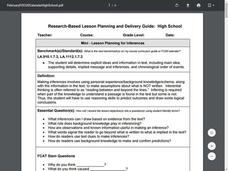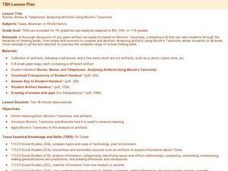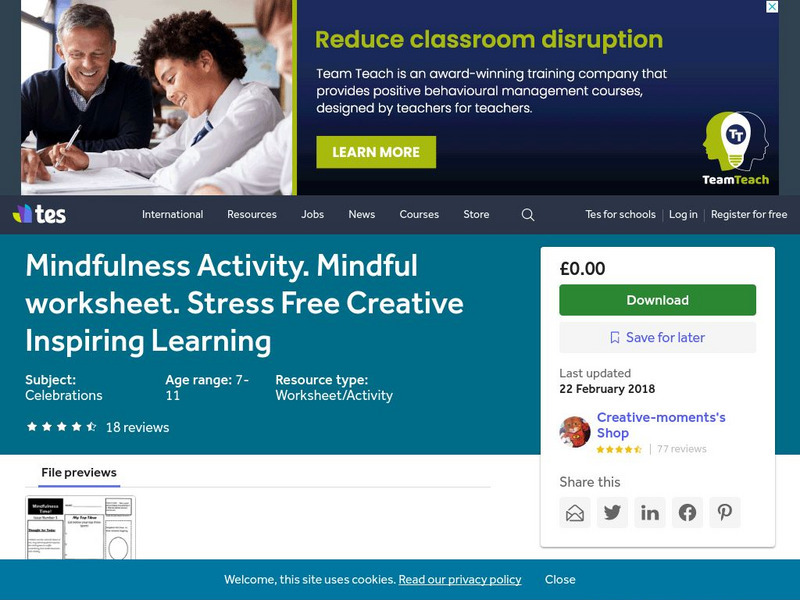Curated OER
Reading Strategies
Good readers have internalized a system of strategies to understand text. While most reading programs explicitly teach these strategies, this presentation could be used as a discussion starter to help students understand such things as...
Curated OER
But I'm Not a Writing Teacher!
How teaching writing skills in the science classroom will benefit your students as they transition to Common Core.
EngageNY
TASC Transition Curriculum: Workshop 8
Lights, camera, action! Math educators consider how to improve their instruction by examining a model of the five-practice problem-solving model involving a movie theater. Participants examine cognitive demand in relation to problem...
Curated OER
Introduction to Writing Traits and Writing Strategies
Intended for an audience of teachers, this presentation lays out the six traits of writing, the writing process, and the teaching process for traits and strategies. If you are trying to understand the writing process more fully, you...
Curated OER
Mini-Lesson Planning for Inferences
Making inferences and drawing conclusions is a key component to successful active reading. Encourage your class to use context clues and prior knowledge to infer different elements of a story, including the setting, plot, and character...
Curated OER
Stones, Bones & Telephones: Analyzing Artifacts Using Bloom's Taxonomy
Seventh graders define metacognition, Bloom's Taxonomy, and artifacts. They, in groups, try to identify a mystery artifact using the Artifact Analysis sheet. They present their findings to the class.
Curated OER
Strategies for Determining the Meaning of a Word
What does that word mean? I can sound it out, but it just doesn't make sense. Teach your class a sure fire strategy to combat those pesky unknown words. You'll introduce the concept of context clues through metacognitive modeling,...
Curated OER
Performing Sonnets
Students use Shakespearean sonnets as part of a poetry analysis instructional activity. In this sonnet instructional activity, students perform a sonnet by Shakespeare but treat it as a script to be acted out. Students work in pairs to...
Novelinks
Touching Spirit Bear: Directed Reading Thinking Activity
What experiences lead people to change and how do they do it? After reading about Cole's encounter with Touching Spirit Bear, readers complete the second out of a series of five activities to predict future events in the text. The...
Novelinks
The Adventures of Tom Sawyer: Directed Reading Thinking Activity
Guide your pupils through The Adventures of Tom Sawyer with a directed reading exercise. The teacher asks questions as the class reads a chapter to help lead learners toward making well-supported predictions.
Curated OER
Getting a Driver's License
Students identify requirements to obtain a driver's license. They describe study and test taking strategies. Students describe reading material. They organize information using restatement and questioning techniques.
Reading Rockets
Reading Rockets: "Seven Strategies to Teach Text Comprehension" by c.r. Adler
In this article, "comprehension strategies" are explained. Supported by research, these strategies are divided into seven different steps, including the following: monitoring comprehension, metacognition, graphic and semantic organizers,...
Edutopia
Edutopia: Teaching Students How to Ask Productive Questions
This article gives insight into how to improve engagement, comprehension, and critical thinking by teaching students the process of asking insightful questions. Included is a comprehensive, metacognitive framework of questioning skills...
Michigan State University
Michigan State University: Intervention for Reading: Story Grammar Training
This intervention emphasizes the importance of metacognitive or active reading strategies to improve comprehension. It directs students' attention on story structure by teaching them to ask five "wh" questions about the settings and...
TES Global
Tes: Mindfulness Activity
[Free Registration/Login Required] In this Mindfulness Activity, students will engage in mini-creative writing tasks. The sheet will simulate each part of the brain as they make lists, draw pictures, and respond to high-interest questions.














